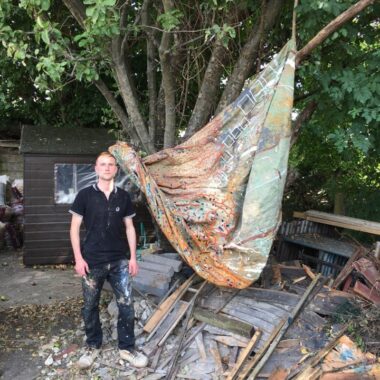How an historical site and the rediscovery of letters written by her great uncle fed into the 2021 exhibition ‘BLAST WALL’ by Lisa Traxler LG
When does a place become home? Is it the building, the memories created, the everyday ordinariness, your belongings surrounding you, the feeling of safety and comfort to retreat to?
During 2015, my partner and I moved to the site of a derelict WWII radar station, the decommissioned RAF St. Lawrence (1), with a house build project ahead of us. This project in unison with the historical site set in motion an unprecedented sequence of events within my art practice. I was surrounded by a myriad of construction materials, practically living on site whilst the project took shape and all within the shadow of this monumental, concrete radar bunker. I found the structure mesmerizing – its clean, sharp lines contrasted with the rugged coastal landscape around it. Distilled in history it had a powerful impact on me.
The collision of construction and history drove the spatial works created for the exhibition BUILD (2) consolidating a physical and emotional response to the house build. A set of vitreous enamelled steel sculptures, Beauty Chorus (3) were produced. These compact interlocking constructions held the memory of the build whilst their hand-painted surface design alluded to defence architecture and military camouflage. Subsequent works, particularly the sculptural Time Traveller (4) series, were fabricated from a resin paper composite originally used in construction on the exterior of the house build and its interior staircase. This exciting evolution of working with non-traditional, industrial materials in an architectural setting enabled me to develop ideas beyond the studio.
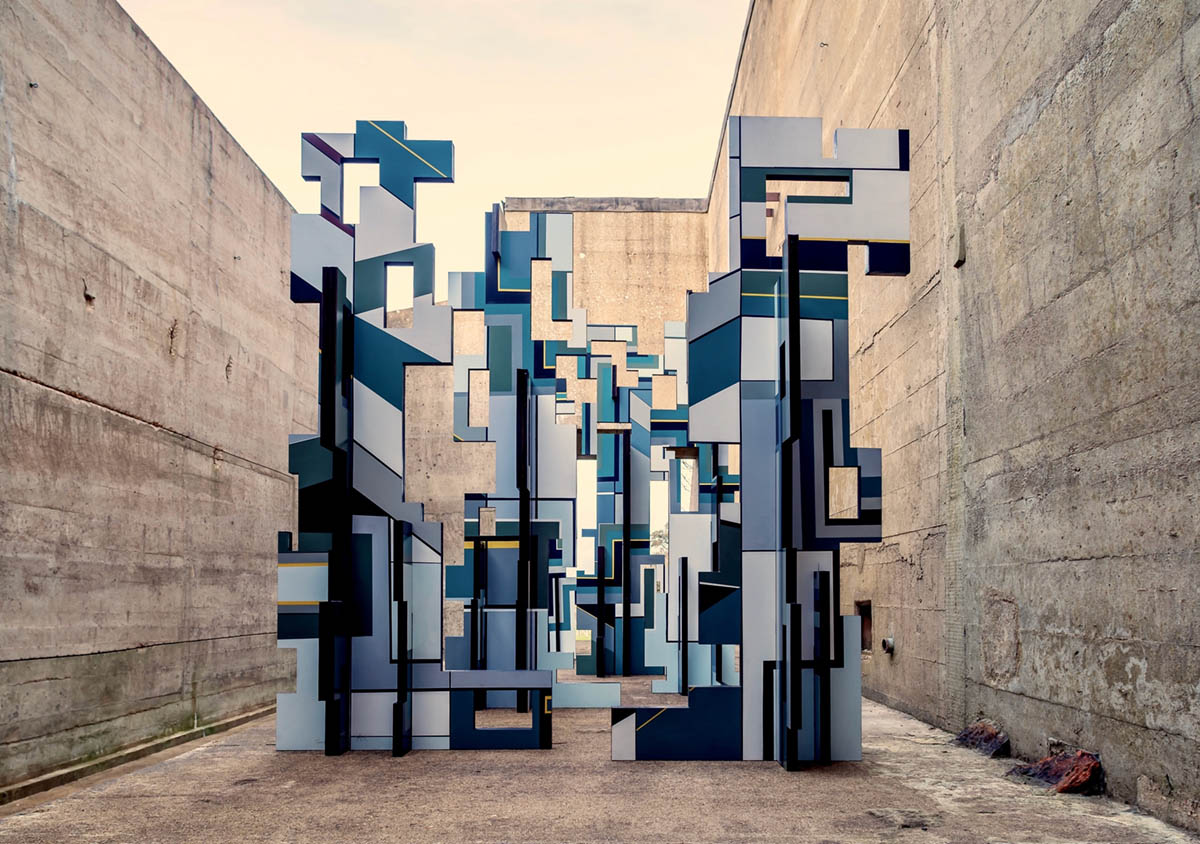
BUILD articulated the endeavour of construction; excavating history, I was a spectator as the project unfolded. Blast Wall is an intimate response, the silent witness now active has become ‘home’. It encapsulates the daily grind, the joy of ordinary, safety, comfort and memories. It is protection from the storm beyond its perimeter. It is also the space where I charted the arc of the sun, watching the sliding shadows of time pass through the long days of lockdown (5). It was my safety net – Home (6).
The blast wall (7) mentioned is one of the surviving components which references part of the radar station of RAF St. Lawrence. This blast wall is located on the seaward elevation protecting the bunker area of the military building that would have housed the generator. It is a concrete structure open to the elements but sheltered on all sides by its thick shuttered and textured hand built concrete elevations. The reinforced concrete embeds a grid of steel rods and is cast in place within a wooden formwork leaving a textured imprint: an evocative memory of its hand-made past. Triangular shaped protected entrances either side give a view through this building to the land beyond. During lockdown this area of the bunker held more significance to me encapsulating the concept of ‘home’ and protection.
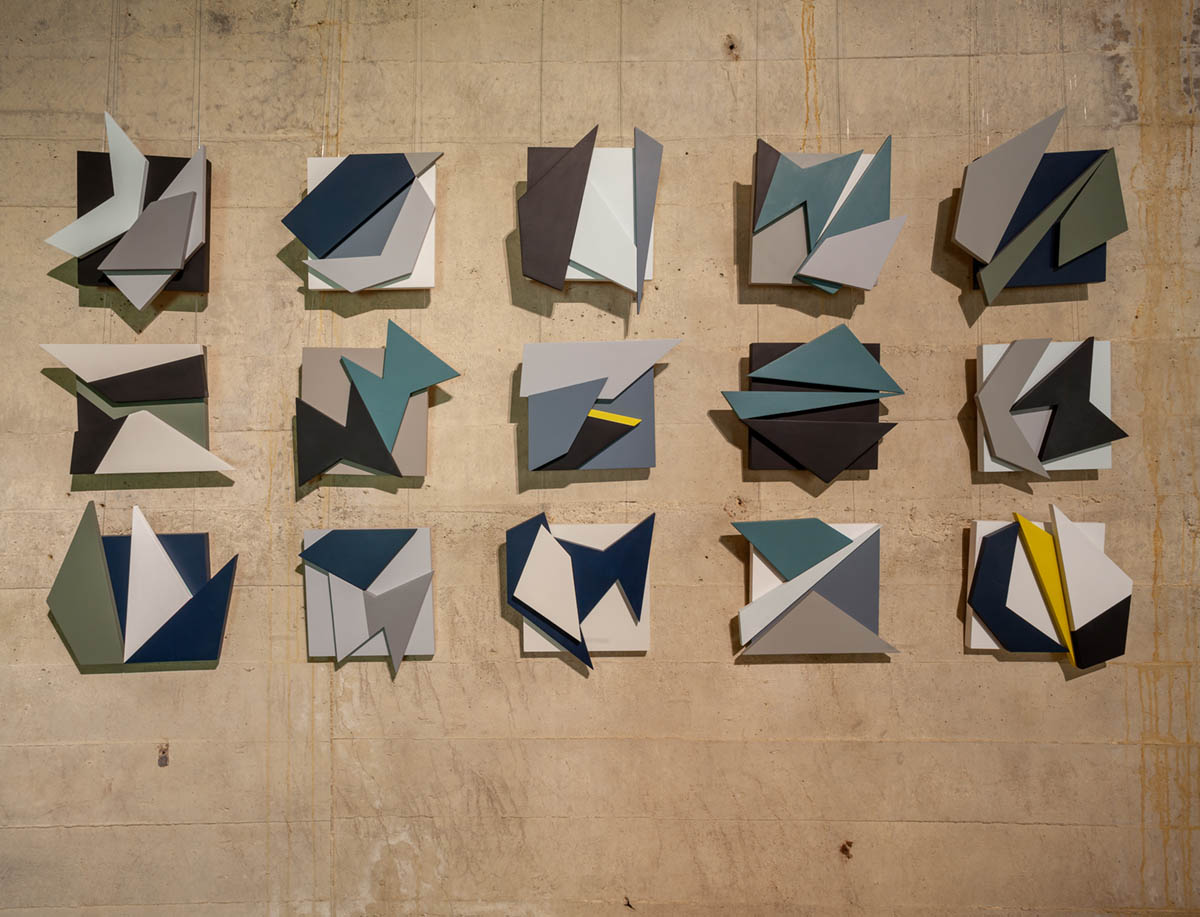
The British painter, Paul Nash, talks of this sense of place that home brings. His family home was important to his emerging concept of place. He wrote: ‘It was undoubtedly the first place which expressed for me something more than its natural features seemed to contain, something which the ancients spoke of as genius loci – the spirit of a place, but something which did not suggest that the place was haunted or inhabited by a genie in a psychic sense … Its magic lay within itself, implicated in its own design and its relationship to its surroundings’ (R. Cardinal, 1989).
Whilst Blast Wall talks about the architectural structure of a piece of defence architecture it also alludes to the emotional history of this period of time through a collection of military letters recently rediscovered by my family. My great uncle was a Lance Corporal posted overseas during the Second World war; he wrote frequently to his sister about his yearning for Home, missing not only his loved ones but also the domesticity of everyday existence. Each time he wrote the word Home he used a capital H, elevating this word to describe the spirit of place, his genius loci.
He writes; ‘India seems so very far from Home – but there – letters fill in the ache – so I guess we can’t grumble – someone has to be out here – don’t they?’
Part of Blast Wall has been transcribing these delicate, faded letters to uncover his story. The writing is beautiful not only in script but in the lyrical way my great uncle describes everyday life. Reading and deciphering these letters whilst creating the Ghost sculptures for Blast Wall has infused this moment in time, intrinsically linked.
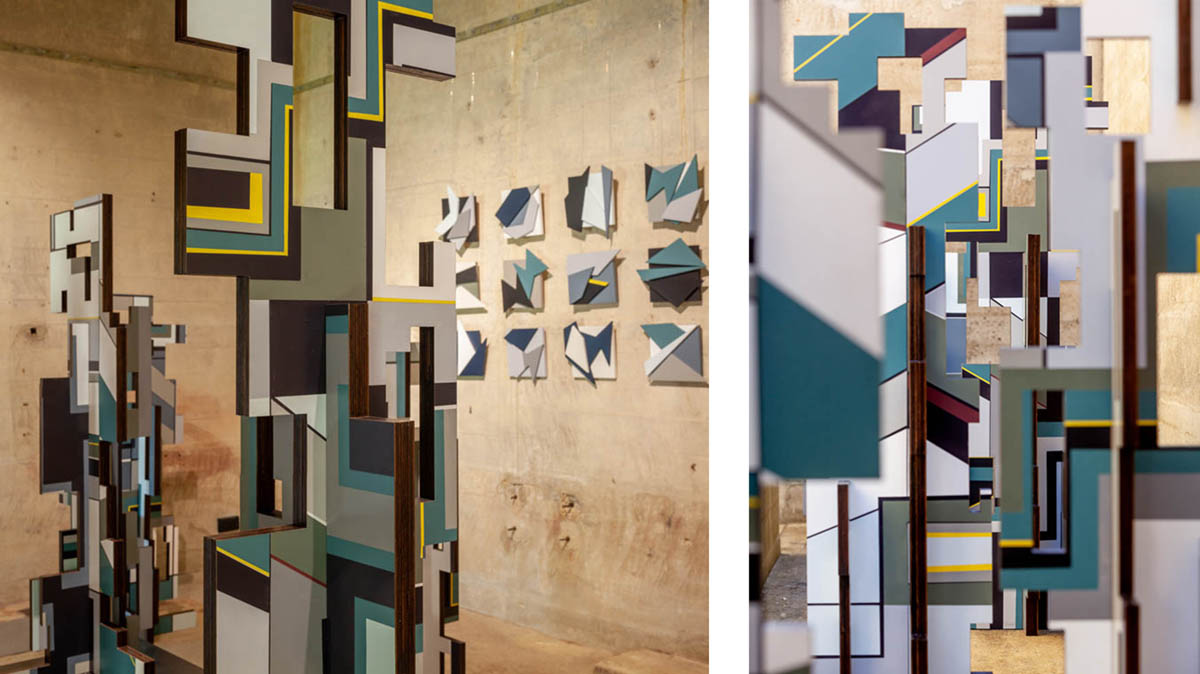
Standing within the blast wall on a clear, bright day, capturing the geometry of light through photographs and sketches I am aware of its solid concrete structure. Watching time measured in shadows creeping across the shuttered walls, open to the elements, the sky above, waiting in its stillness.
He writes ‘The weather has been very hot and dry for the past few months. The ground could do with a soaking – it’s dry and cracked as hard as iron – and the dust is horrible.’
Above us both the same sky… but a different time and space.
Quietened by the noise of ‘outside’ during the strange time of lockdown gave me time and space to explore my interdisciplinary practice. This experimentation created new ways of bringing the two- and three-dimensional aspects of my work together.
Six painted Ghost sculptures suggest the construction of the blast wall and the shape of time passing with their geometric, upright hand-painted planes. This process follows weeks of drawing, maquette building and panel painting with the final procedure offsite and the panels fabricated in an industrial setting. These vertical pieces slot together forming floor-based works to be viewed in rotation creating an immersive experience of my paintings. The edges of each structure creating their own space sculpture – intervals in time. Within these shaped forms apertures are cut, echoing the blast wall slots and openings, through which the landscape wall piece 20 Letters can be viewed. This wall sculpture alludes to the twenty letters from my family history whilst also creating a lineage utilising excess shapes from previous works. These forms are reconfigured and re-worked, their colour palette pertaining to the rugged land, bunker patina and military camouflage working in unison.
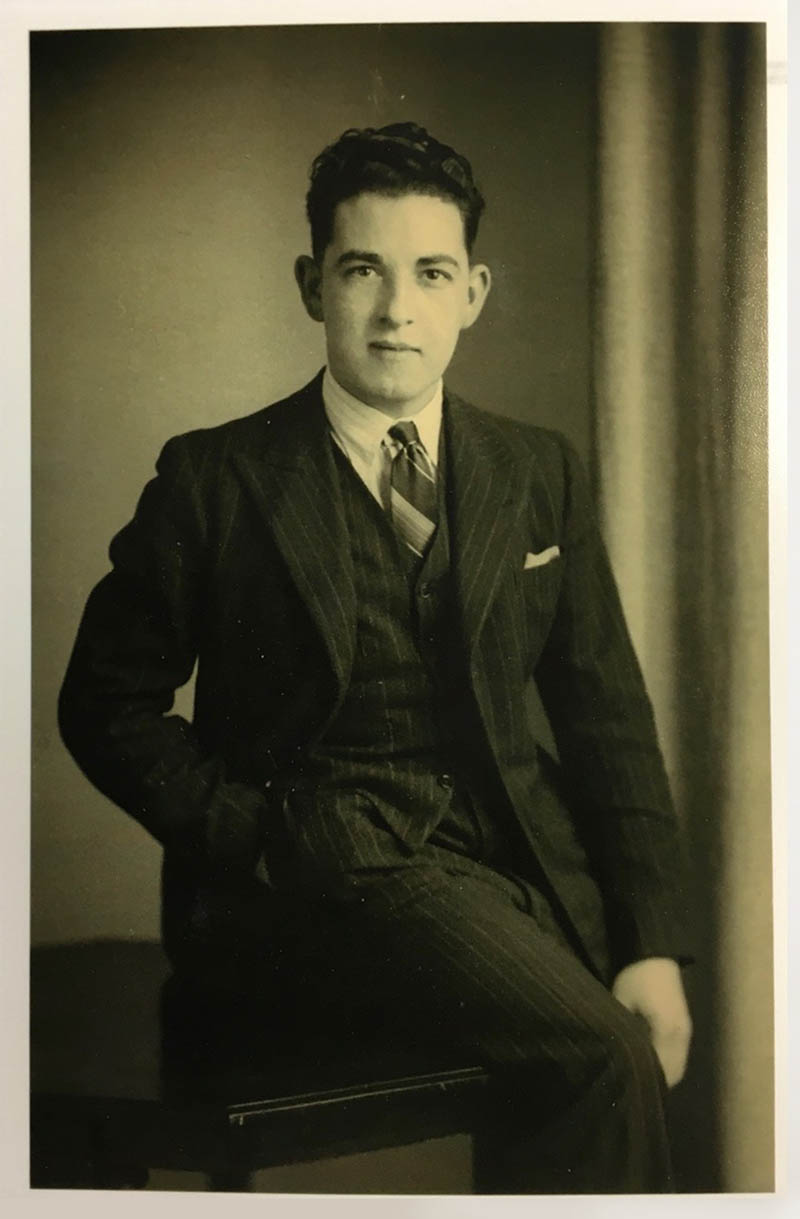
My great uncle never did make it home, dying in battle on 11 June 1944 and buried in the Kohima War Cemetery. His letters are significant, not only to his family but for himself. By writing he brought himself ‘Home‘ creating his genius loci through the ink on the paper to his connection to his sacred place. Notes Title: There’s Nothing Like Home, a phrase written by my great uncle in one of his letters, November 19th 1941.
Lisa Traxler 2021
The images show the GHOST sculptures and the wall sculpture is a detail of ’20 LETTERS’ by Lisa Traxler for the Arts Council supported solo exhibition ‘BLAST WALL’ at The Foundry Gallery, London and The Bunker, IW, 2021.
The essay ’Nothing Like Home’ by Lisa Traxler first appeared in the exhibition catalogue of ‘BLAST WALL’
1.) RAF St. Lawrence was built in 1941 and operational 24 hours a day until decommissioned in 1947. It was part of the Chain Home network, a series of 20 radar stations creating a national defence system to protect Britain’s coastline during WW2.
2.) BUILD, 2017. Solo exhibition Penwith Gallery, St. Ives, Cornwall, and Surface Matter Materials Gallery, Hackney, part of London Design Festival, 2017.
3.) Beauty Chorus, a set of eight vitreous enamelled steel sculptures hand painted by the artist and fabricated in A.J Wells & Sons, IW, exhibited in ‘BUILD’.
4.) Time Traveller, initial sculpture from this series, fabricated in a resin paper composite industrial material.
5.) Lockdowns of 2020/2021 due to the Covid-19 pandemic.
6.) Safety Net – Home, a series of constructed collage paintings created during lockdown 2020.
7.) A blast wall is a barrier designed to protect vulnerable buildings or other structures and the people inside them from the effects of a nearby explosion, whether caused by industrial accident, military action or terrorism.’ (from Wikipedia, 2020)
Exhibitions
The Bunker Gallery Summer Exhibition
26 – 29 August 2022
Open 11am – 4pm daily
The Bunker Gallery, Old Park Road, St. Lawrence, Isle of Wight PO38 1XR
The Bunker Gallery is housed in a decommissioned WW2 radar bunker. Home of award winning artist Lisa Traxler and her architect husband, Lincoln Miles.
Time Traveller
2 July – 8 October 2022
An exhibition of dazzle, dissection and transformation by Lisa Traxler
Southampton City Art Gallery, Commercial Road, Southampton SO14 7LP

